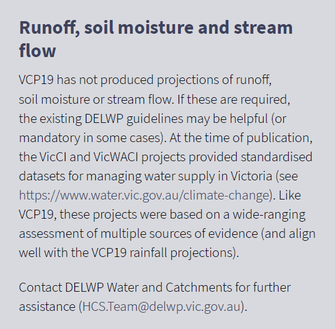Climate Change in Australia
Climate information, projections, tools and data

Using climate projections in an impact assessment
Chain of actions
To pursue the top-down part of an IAV assessment, there are a few underpinning principles, and a chain of actions to follow:
- Before using climate projections, it is important to do relevant background reading, identify relevant stakeholders and determine the appropriate level of stakeholder engagement.
- Next, determine the need/s for climate change data and information.
- Obtain appropriate information and/or data (use the decision tree ).
The information from VCP19 and similar sources may be enough for basic purposes or raising awareness (the first branch in the decision tree), or it may be the start of further analysis. An initial assessment (sometimes called a ‘first pass assessment’ or ‘scan’) should be done before any detailed analysis. Following a scan, if more detailed information is needed then a detailed study can be scoped and carried out.
All IAV applications, including those in the water domain, should start with an assessment of past and future climate changes and the impact they have – this involves collecting and processing appropriate climate datasets from the Bureau of Meteorology, VCP19, CCIA and others, as well as data sets relevant to the application (e.g. databases of assets, networks and infrastructure).
Establishing plausible future climate conditions (scenarios or projections) is just one of many steps in knowing what climate change means to any application, and what to do in response. To assess the impacts, adaptation and vulnerability (IAV) aspects of future climate risk, we need to bring in other knowledge and information, and do further analysis.
Planning for managing future climate risk involves a combination of:
- ‘Top-down’ analysis – starting by constructing climate projections and feeding them into a chain of analyses such as applied models to understand what this change in the climate means to a downstream application (e.g. feeding rainfall and evaporation into a runoff model to assess changes in water availability and river flows). This top-down chain may include a downscaling step to provide regional insights in the projected changes. The VCP19 project included downscaling for this purpose.
- ‘Bottom-up’ analysis – assessing the vulnerability and resilience of systems, and pathways to reduce vulnerability and increase the capacity to cope or transform (without consideration of climate projections).
As projections of future climate include considerable uncertainties, a simple ‘predict then act’ framework is not suitable. Instead, we must consider the range of possibilities in four main respects:
- Natural climate variability
- Emissions scenarios
- How the climate may respond to increasing greenhouse gases (estimated from a range of models)
- Understanding the level of confidence that can be applied to each projection and/or model simulation.
- consider the full range of plausible change as projected by all available climate modelling
- evaluate multiple emissions scenarios (at least two)
- account for natural climate variability (which will be superimposed over climate trends)
- use an objective means (such as the Climate Futures approach) to select a subset of data that is relevant to the assessment being undertaken.

In addition, some aspects of decision-making are specific to the application, including the time horizon and the tolerance for risk. There are also factors of political will, economic resources and social license to operate that must be considered.
Once:
- stakeholders are identified
- the engagement plan is set
- historical climate impacts and vulnerability are understood
- the information needs are assessed
- the initial scan is completed
...then
future climate datasets can be collected and climate projections
constructed. This is where the Climate Futures tool
and the VCP19 datasets
may be useful, as described in the next section.
After
climate projections have been constructed and used in applied analyses,
the results should be interpreted and communicated via appropriate
means, and the outcomes assessed. Then the cycle can be repeated, and
the scan of needs can start again.
------------
Page updated 24th December 2020



